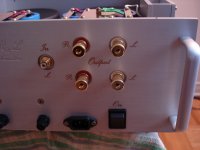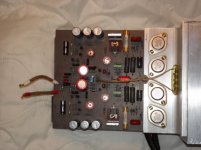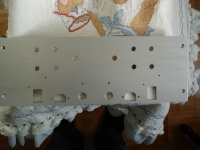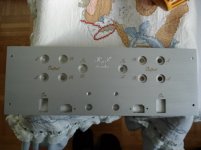Scorpion said:
It seems like there is no consensus on wether IXYS bridges are the way to go (at least it seems to be the opinion of BeanZ). Comments on the sound of Digikey diodes and/or IXYS bridges would be appreciated.
After reading your posts I have no doubt that 2 bridges per channel are the way to go. That's exactly what I am going to do. I'll just have to select the proper one.
Marc-André Rodrigue
When you use two bridges and two windings (for plus and minus supply) you won't load the transformer so much. If you use only one bridge you half wave rectify the current in each winding and this creates more losses in the transformer but you get half in rectifier losses. You win also a volt or two. I gather the losses thing is not important in your case....
Correction: My statement is true (or more true) if the load is unsymmetrical, not likely in an amp....) It's very true if you connect the windings in parallel. You can then get losses due to not equal voltage...
My recommendation is that it's no harm to use two bridges if you can afford it and/or have the room them.
My bridge type recommendation is a slow ordinary type with 4 caps. Use 10-100nF film or ceramic, good HF performance. 100 nF polyester 63V or 100V is quite alright.
You can also use a faster bridge but beware of the emission and decouple it carefully.
We'll cross that bridge
"My bridge type recommendation is a slow ordinary type with 4 caps. Use 10-100nF film or ceramic, good HF performance. 100 nF polyester 63V or 100V is quite alright.
You can also use a faster bridge but beware of the emission and decouple it carefully"
Use RC snubbers instead of just caps.
High speed soft recovery diodes generate MUCH LESS RFI noise. That is the point of using them.
Two bridges are worth using to keep the charging current out of the finite impedances of the power supply ground wiring.
The load on a power amplifier is asymmetric during large bass transients and music signals are also asymmetric.
I suggest all interested do a search since this has been discussed in some detail in the forum.
H.H.
"My bridge type recommendation is a slow ordinary type with 4 caps. Use 10-100nF film or ceramic, good HF performance. 100 nF polyester 63V or 100V is quite alright.
You can also use a faster bridge but beware of the emission and decouple it carefully"
Use RC snubbers instead of just caps.
High speed soft recovery diodes generate MUCH LESS RFI noise. That is the point of using them.
Two bridges are worth using to keep the charging current out of the finite impedances of the power supply ground wiring.
The load on a power amplifier is asymmetric during large bass transients and music signals are also asymmetric.
I suggest all interested do a search since this has been discussed in some detail in the forum.
H.H.
I know this is an old thread, but I was surprised that nobody mentioned the Chord Electronics amps (UK, nothing to do with with Chord interconnects). All of their amps have used SMPS for at least a decade, possibly two. These are very highly regarded-and expensive-units.
Check out this site: www.chordelectronics.co.uk
They look gorgeous too!
Check out this site: www.chordelectronics.co.uk
They look gorgeous too!
Hi Persig
The Chords are indeed an exception. They don't have an SMPS for cost reasons but because they are convinced that their power supply is better than a conventional supply.
But there is much effort put into the development and construction of their SMPS compared to a PC grade powersupply, i.e. it is definitely NOT cheaper than a conventional power supply.
I once heard a real beefy Chord amp connected to a newer Tannoy Speaker (I think the name was "Dimension 12"). And I can confirm the combination sounded clean and pleasing. And when cranked up it sounded still that clean and unstrained but quite brutal !
Chord amplifiers are the ones that are recommended for use with the larger Dynaudio Acoustics Studio Monitors.
Even though I once developped an SMPS, I would strongly recommend generously designed conventional powersupplies for DIY.
Regards
Charles
The Chords are indeed an exception. They don't have an SMPS for cost reasons but because they are convinced that their power supply is better than a conventional supply.
But there is much effort put into the development and construction of their SMPS compared to a PC grade powersupply, i.e. it is definitely NOT cheaper than a conventional power supply.
I once heard a real beefy Chord amp connected to a newer Tannoy Speaker (I think the name was "Dimension 12"). And I can confirm the combination sounded clean and pleasing. And when cranked up it sounded still that clean and unstrained but quite brutal !
Chord amplifiers are the ones that are recommended for use with the larger Dynaudio Acoustics Studio Monitors.
Even though I once developped an SMPS, I would strongly recommend generously designed conventional powersupplies for DIY.
Regards
Charles
...In the context of this forum, linear supplies are easier to understand, design, build, test, and repair. They have the reputaion of "sounding" better.
Agreed, it's the route of choice for pretty much all of us. PSU for my A75 is to be PI filter, traditional but sound (sic!).
A question for Scorpion:
. Where is this surplus store please? A website would be most helpful, but an address will help.I bought lot of stuff from a surplus store. For exemple, Mallory CGS capacitors cost me a total of 70$ CAN (45$ US) for 4 70V 40 000uf and 8 75V 20 000uF !!!
Thanks
IXYS
The IXYS high speed soft recovery diodes are excellent. I have also used RC snubber on hign speed diodes and seen reduction of high frequency noise. The only reason I can think of to use regular slow diode bridges is to save money. I have changed to high speed soft recovery diodes on dozens of audio circuits with great results.
http://www.gensemi.com/appnotespdf/quik108.pdf
http://www.ixys.com/
http://131.109.59.51/images/pdf/Calculatin_%
20Optimum_Snubbers.pdf
http://www.gensemi.com/appnotespdf/quik108.pdf
The IXYS high speed soft recovery diodes are excellent. I have also used RC snubber on hign speed diodes and seen reduction of high frequency noise. The only reason I can think of to use regular slow diode bridges is to save money. I have changed to high speed soft recovery diodes on dozens of audio circuits with great results.
http://www.gensemi.com/appnotespdf/quik108.pdf
http://www.ixys.com/
http://131.109.59.51/images/pdf/Calculatin_%
20Optimum_Snubbers.pdf
http://www.gensemi.com/appnotespdf/quik108.pdf
Scorpion...
Scorpion
You said :" He personnaly knows the owners (see inventors) of companies like Sim Audio, Classé, Totem (years ago) and especially Tenor Audio (recently)and has sometimes helped or commented on their project (some of the Tenor Audio stuff are now on the market)."
What is the name of this guy?
Luke123
Scorpion
You said :" He personnaly knows the owners (see inventors) of companies like Sim Audio, Classé, Totem (years ago) and especially Tenor Audio (recently)and has sometimes helped or commented on their project (some of the Tenor Audio stuff are now on the market)."
What is the name of this guy?
Luke123
Hi all,
I know it was years ago but should you guies be interested in how my dual-mono power amp looks, here are a few pictures. It weights 140 lbs !!!
This is the MKII version as I modified a few things along the way.
Should you have any questions, please don't hesitate.
Regards
Marc-André alias ''Scorpion''
I know it was years ago but should you guies be interested in how my dual-mono power amp looks, here are a few pictures. It weights 140 lbs !!!
This is the MKII version as I modified a few things along the way.
Should you have any questions, please don't hesitate.
Regards
Marc-André alias ''Scorpion''
Attachments
Hi all,
Here are a few answers to your questions:
First, I bought the boards from that fellow audiophile from the Montreal region that might start a business with these so unfortunately, I am not allowed to give schematics. I know it will disappoint a lot of people but that is just how it is. Sorry here.
If I sum up the characteristics....
Briefly, EACH CHANNEL is built as follow:
--1 KVa customized Plitron LONO transfo with NO thermistor/thermal switch, NO extra winding for 230V...but with a bigger AWG for wires and therefore NO junctions whatesoever (better current capability and transparency). A real improvement in transparency from the MK I version wich used stock Plitron LONO transfos.
--Power supply using 4 Mallory 40 000 uF CGS caps for a total of 160 000 uF per channel .
-- Bipolar boards with 4 outputs per channel mounted directly on boards, working in class AB, running at +- 64V, boards made of Teflon OFC 4 onces (like in big Levinson) with a dielectric of +- 2, traces sfully balanced, impedance fully balanced, heatsink and output transistors mounted directly on boards so they are fully operationnal even without a chassis, each electrolytic can is bypassed by a prolypolen cap (Mundorf Silver/Oil or Dynamicaps) directly on boards.
-- Ixys soft recovery bridges for B+ and B- per channel (so 2 bridges per channel)
-- Black Gate NX, Mixture of Mundorf Silver/Oil and Dynamicap, capacitors on specific locations on boards and Zobels (after listenning sessions)
-- Mixture of Allen-Bradley, Vishays and NOS dale resistors on specific locations ( after listenning sessions)
-- Mixture of solders (each and evry one of them chosen for sonic characteristics after listenning sessions) ranging from VDH 3% silver, Cardas tri-Eutectic (lead free) and Johnson IA 423.
-- Hi-Fi Tuning fuses (too much hype here), Acme cryo Copper/ silver fuseholders, WBT topline connectors, Furutech copper/gold inlets, copper lugs and stainless and/or brass screws etc...were little toys to experiment with as part of fine tuning that I finally left in place (there not bad though).
--7 to 16 6N-multistranded twisted-copper-braids (with Teflon insulation) per wire throughout..
-- One power cord per channel.
-- Black Diamond Racing cones (3) underneath (had to fine tune were they would end up by ears)
-- Metal work is made of 5/16 '' 6061 aluminium all around
The amp delivers 240W at 8 ohms, 480 at 4 ohms and 946 at 2 ohms...don't have the measurements at the punishing 1 ohm though...But sincerely, I don't have other measurements as I don't really care about how things measure but only about how they sound and if I get emotionnally involved in the realism of music....
TO FELIXX: The customized Plitron LONO are truly excellent, no noise, humm or buzz whatesoever and since they are encapsulated, magnetic field isn't a concern. But BTW, how can I know wheater I have a magnetic stray effect from trannies to modules ??
TO MAXPOU: Craftmanship was made by myself (I used to work in Aerospace for years...now as a nurse in a ICU...go figure !!!). Odd angles and too complicated stuff was done at EMAM (Ecole Métiers Aerospatiale Montreal) as I new a teacher down ther (a friend) that did the complicated stuff for me., Writing was done at Gravures Desmarais in Montreal (excellent place) while anodizing was made at Verdun Anodizing in Verdun.
Regards
Scorpion
Here are a few answers to your questions:
First, I bought the boards from that fellow audiophile from the Montreal region that might start a business with these so unfortunately, I am not allowed to give schematics. I know it will disappoint a lot of people but that is just how it is. Sorry here.
If I sum up the characteristics....
Briefly, EACH CHANNEL is built as follow:
--1 KVa customized Plitron LONO transfo with NO thermistor/thermal switch, NO extra winding for 230V...but with a bigger AWG for wires and therefore NO junctions whatesoever (better current capability and transparency). A real improvement in transparency from the MK I version wich used stock Plitron LONO transfos.
--Power supply using 4 Mallory 40 000 uF CGS caps for a total of 160 000 uF per channel .
-- Bipolar boards with 4 outputs per channel mounted directly on boards, working in class AB, running at +- 64V, boards made of Teflon OFC 4 onces (like in big Levinson) with a dielectric of +- 2, traces sfully balanced, impedance fully balanced, heatsink and output transistors mounted directly on boards so they are fully operationnal even without a chassis, each electrolytic can is bypassed by a prolypolen cap (Mundorf Silver/Oil or Dynamicaps) directly on boards.
-- Ixys soft recovery bridges for B+ and B- per channel (so 2 bridges per channel)
-- Black Gate NX, Mixture of Mundorf Silver/Oil and Dynamicap, capacitors on specific locations on boards and Zobels (after listenning sessions)
-- Mixture of Allen-Bradley, Vishays and NOS dale resistors on specific locations ( after listenning sessions)
-- Mixture of solders (each and evry one of them chosen for sonic characteristics after listenning sessions) ranging from VDH 3% silver, Cardas tri-Eutectic (lead free) and Johnson IA 423.
-- Hi-Fi Tuning fuses (too much hype here), Acme cryo Copper/ silver fuseholders, WBT topline connectors, Furutech copper/gold inlets, copper lugs and stainless and/or brass screws etc...were little toys to experiment with as part of fine tuning that I finally left in place (there not bad though).
--7 to 16 6N-multistranded twisted-copper-braids (with Teflon insulation) per wire throughout..
-- One power cord per channel.
-- Black Diamond Racing cones (3) underneath (had to fine tune were they would end up by ears)
-- Metal work is made of 5/16 '' 6061 aluminium all around
The amp delivers 240W at 8 ohms, 480 at 4 ohms and 946 at 2 ohms...don't have the measurements at the punishing 1 ohm though...But sincerely, I don't have other measurements as I don't really care about how things measure but only about how they sound and if I get emotionnally involved in the realism of music....
TO FELIXX: The customized Plitron LONO are truly excellent, no noise, humm or buzz whatesoever and since they are encapsulated, magnetic field isn't a concern. But BTW, how can I know wheater I have a magnetic stray effect from trannies to modules ??
TO MAXPOU: Craftmanship was made by myself (I used to work in Aerospace for years...now as a nurse in a ICU...go figure !!!). Odd angles and too complicated stuff was done at EMAM (Ecole Métiers Aerospatiale Montreal) as I new a teacher down ther (a friend) that did the complicated stuff for me., Writing was done at Gravures Desmarais in Montreal (excellent place) while anodizing was made at Verdun Anodizing in Verdun.
Regards
Scorpion
Scorpion
About the #28 post to which no answer has been given from you...
Who is this person?
Nobody seems to know you from Tenor Audio!!!
They never heard of Marc-Andre Rodrigue!
Or any other person that could have helped Tenor Audio's designer.
Your claims seems to be false as I personally know Michel, Tenor Audio's designer.
And He never heard of you...at all!
Luke123
About the #28 post to which no answer has been given from you...
Who is this person?
Nobody seems to know you from Tenor Audio!!!
They never heard of Marc-Andre Rodrigue!
Or any other person that could have helped Tenor Audio's designer.
Your claims seems to be false as I personally know Michel, Tenor Audio's designer.
And He never heard of you...at all!
Luke123
Hi Luke123,
Of course they don't know me as I don't know them either (except from seeing Robert Lamarre, Michel Vanden Broeck and pals at the Montreal's Festival Son & Image).
I am not the person that knows them but the guy that helped me with the project has seen/meet different Audio manufacturers from Quebec several times and has more than once commented and/or evaluated some products before they hit the market and were still projects.
This guy has more than 25 years of experience in audio (building stuff). He is from Southshore Montreal. He just doesn't want to be named on this forum and I have to respect that.
So my claim was NOT false at all.
Regards
Marc-André
Of course they don't know me as I don't know them either (except from seeing Robert Lamarre, Michel Vanden Broeck and pals at the Montreal's Festival Son & Image).
I am not the person that knows them but the guy that helped me with the project has seen/meet different Audio manufacturers from Quebec several times and has more than once commented and/or evaluated some products before they hit the market and were still projects.
This guy has more than 25 years of experience in audio (building stuff). He is from Southshore Montreal. He just doesn't want to be named on this forum and I have to respect that.
So my claim was NOT false at all.
Regards
Marc-André
- Status
- This old topic is closed. If you want to reopen this topic, contact a moderator using the "Report Post" button.
- Home
- Amplifiers
- Solid State
- New dual-mono power amp



